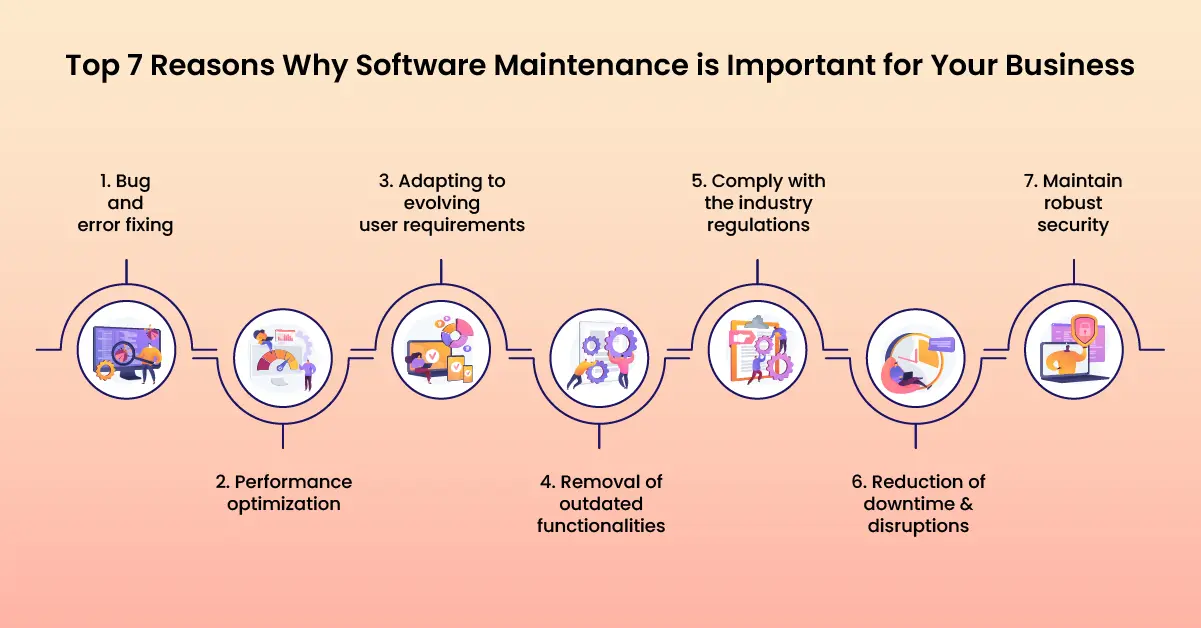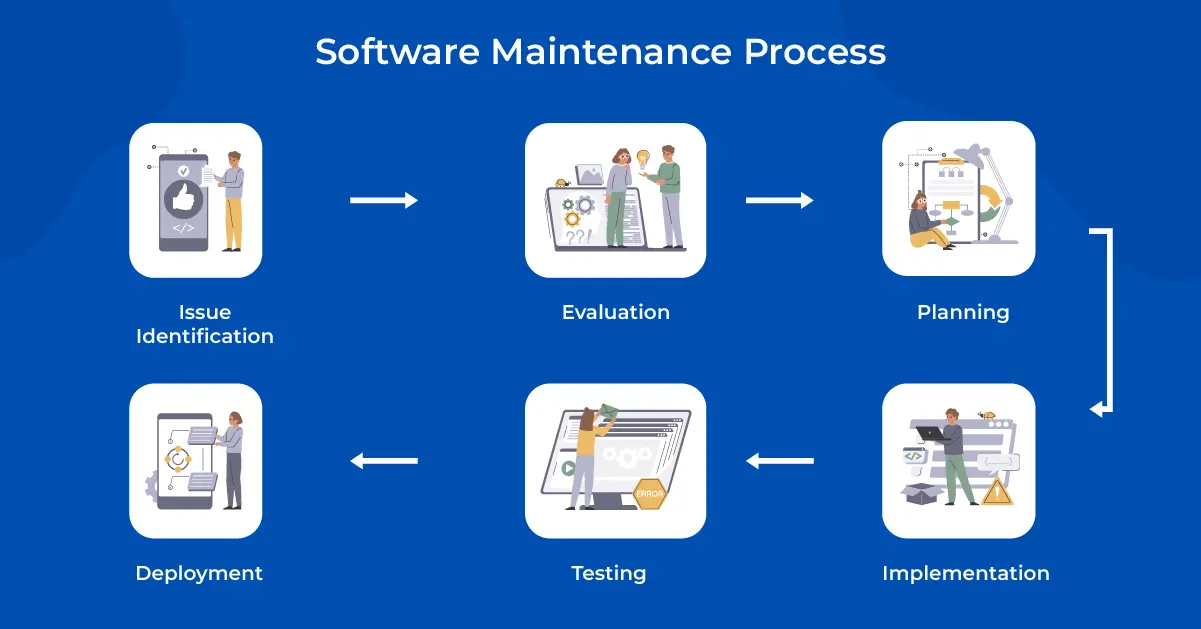In today's technology-driven world, software works like an engine for modern businesses. In most cases, running a business becomes impossible even for a few minutes if the applications don't work properly.
Take the example of an ecommerce business! What will happen if your application or website stops working for some time? It will cause operational disruptions and massive revenue loss. But, these are only short-term impacts.
Software downtime can have long-term implications, such as customer dissatisfaction, losing out in the competition, data theft, compliance, legal risks, and penalties. Just like developing cutting-edge software is essential for businesses, maintaining them is also critical. This blog covers everything you need to know about software maintenance for your business.
This Article Contains:
What is Software maintenance?
Software Maintenance is a continuous process of modifying or updating a software system to fix errors, improve performance, keep it up-to-date, and ensure it delivers optimal performance in every condition. For example, fixing bugs or updating security patches is a software maintenance activity. Maintaining your software has many benefits, including extended software lifespan, enhanced user satisfaction, cost savings, and many others.
What are the 4 Types of Software Maintenance?
There are several types of software maintenance activities and each serves a specific purpose. Let’s look at different types of software maintenance.
1. Preventive maintenance
Preventive maintenance is a proactive approach to software maintenance where you take preventive measures to avoid potential failures before they become critical and disrupt business operations. It involves identifying and fixing bugs, updating documentation, and optimizing code to make the software more reliable, stable, and in working condition.
2. Corrective maintenance
Corrective maintenance is a type of reactive maintenance when your users report, or the monitoring system discovers some issues. It involves diagnosing, identifying, and fixing the software problem affecting its functionality or performance. These problems can impact various application parts, including the user interface and backend functionalities, and may lead to poor performance or even crashes, making the software unusable.
3. Adaptive maintenance
Adaptive maintenance involves aligning the software system to the changing business demands and technological advancements. The main objective of this type of maintenance is to ensure that software remains compatible, functional, and efficient despite changes in operating system, hardware, regulatory and compliance requirements, or user demands.
4. Perfective maintenance
Perfective maintenance involves fixing issues related to performance, functionality, and usability. It encompasses identifying and addressing issues within the software where performance can be optimized, such as speeding up execution times, reducing memory usage, or adding new features or functionalities to the software to meet evolving user needs.
For example, redesigning UI elements for easy navigation and adding advanced search functionalities or filters to enhance the search function.
Top 7 Reasons Why Software Maintenance is Important for Your Business
Many business owners think, “What is the importance of software maintenance?” Well, there are multiple reasons. They are:-

1. Bug and error fixing
Bugs, errors, and defects may appear in your software system with time. These issues may lead to unusual behavior, malfunctioning, security vulnerabilities, and crashes, resulting in user dissatisfaction, productivity loss, and data theft. Resolving these issues promptly ensures an enjoyable user experience and prevents them from escalating.
2. Performance optimization
The performance of your software may degrade over time due to various factors like an increase in the number of users, changes in user behavior, higher data volume, incompatibility with new hardware, or other issues.
Maintaining your software ensures stable and reliable performance under all conditions. Besides, performance optimization, software maintenance also improves responsiveness and speed, improving user satisfaction, increasing productivity, and saving cost.
3. Adapting to evolving user requirements
Users' expectations constantly evolve due to the inception of new technologies, features, or other factors. Businesses should respond to changing user requirements to stay relevant and competitive. Regular software maintenance enables companies to enhance customer experience by integrating emerging technologies and ensuring the software delivers optimized performance.
4. Removal of outdated functionalities
Outdated features and functionalities significantly impact a software's performance, and increase security vulnerabilities and non-compliance with legal requirements. It may lead to user dissatisfaction and data breaches and put the organizations at risk of fines and penalties. Removing outdated functionalities improves the software's efficiency.
5. Comply with the industry regulations
This is another reason why maintenance of software is important. Complying with legal regulations such as GDPR, HIPAA, or PCI DSS is essential for businesses as they help protect sensitive user data and avoid penalties. Regular maintenance of your software systems ensures they remain compliant with the industry regulations, helping you earn your partners' and customers' confidence.
6. Reduction of downtime & disruptions
In today's digital era, businesses across industries rely on software for the smooth running of their business. Software downtime can significantly affect your business from financial loss and reputational damage. According to a Colorlib report, 57% of users abandon a site if it takes more than three seconds to load. Maintaining your software can help you reduce downtime, maximize productivity, minimize security breaches, and improve customer satisfaction.
7. Maintain robust security
In today's digital and interconnected world, software vulnerabilities are like an invitation to hackers and cybercriminals, which can cost your business drastically. A Statista report reveals the average cost of a data breach across companies globally is 4.45 million U.S. dollars. This makes it essential for businesses to keep their software updated to minimize cyber threats as much as possible.
4 Key Challenges in Software Maintenance
Now that you know why software maintenance is important, let's look at the top four challenges of software maintenance.
1. Legacy code
Legacy code means code written in obsolete programming languages or frameworks, which is difficult to understand and modify. Dealing with legacy code may pose several challenges for developers to maintain and update the code because of their limited understanding of older technologies. Besides, there will be compatibility issues with the emerging technologies.
2. Complexity
Software systems may become complex over time with the addition of new features and as dependencies between different components grow. Optimizing the performance of such complex software without compromising the functionalities requires a deep understanding of the software's architecture and a clear roadmap, otherwise, it becomes difficult to maintain them.
3. Cost
Allocating a budget for software maintenance is another major challenge for businesses as it requires skilled developers, testers, and other resources, which can incur significant costs. The cost can vary depending on several factors, such as the size and complexity of the software, in-house or outsourced teams, and technology stack.
4. Time
Software maintenance is essential because delayed bug fixes or slow feature releases can lead to complex problems and customer dissatisfaction. However, it requires a lot of time for maintenance, from planning to execution, making it challenging for businesses. Companies need to find the least productive time for this as software maintenance may affect business operations.
Software Maintenance Process
Software maintenance is critical for every organization to ensure all the applications work properly. From identifying the issues to implementing the changes and optimizing performance, the software maintenance process goes through a few key steps.

1. Issue Identification
It is the first step of software maintenance where the team identifies and documents issues reported by users, or automated monitoring systems. It involves prioritizing issues based on their impact on business, helping the team to determine which ones require immediate attention.
2. Evaluation
In this step, the team assesses the identified issues to understand their root causes and find potential solutions. They gather relevant data such as user feedback, system logs, and performance metrics for the evaluation process.
3. Planning
The team creates a comprehensive plan, outlining the steps required to address the issues. The phase also involves defining the objectives, allocating resources, and setting a timeline for every task while considering risk mitigation, budget constraints, and stakeholder expectations.
4. Implementation
The team executes the planned maintenance activities, such as bug fixing, performance optimization, feature enhancements, security updates, and other steps. They need to follow the best practices for coding, documentation, and version control to ensure changes are implemented correctly and effectively.
5. Testing
Testing is an integral part of the software maintenance process to ensure the maintenance activities are working correctly. By conducting testing throughout the maintenance process, the development teams can mitigate the risks and uphold the software's reliability.
6. Deployment
Once the software maintenance and testing is completed, the software is deployed for the users. The developers then monitor how the software works after deployment. In case of any unexpected issues or adverse effects on system performance, they revert the changes and restore the previous working state to ensure minimal disruption and work on maintenance to resolve the issue.
Top 4 Software Maintenance Models
Software maintenance is essential for every business to keep the software secure, and up-to-date. Various maintenance models have evolved to address different needs and challenges. Let's look at the top models.
1. Quick-Fix Model
This model involves identifying the glitches and fixing them quickly. The focus is on providing faster solutions to immediate issues to minimize disruption for the users. The benefits of this model are it is cost-effective and fixes the problems promptly.
2. Iterative enhancement model
The Iterative maintenance model is based on the principle of iterative development, where the team continuously improves the software through incremental changes. It involves comprehensive documentation and regularly refining the software to incorporate new features and adapt to evolving user requirements.
3. The Reuse oriented model
This model focuses on reusing the usable existing software components or modules to streamline maintenance efforts and improve efficiency. This model reduces the development time and cost by leveraging existing tested components.
4. Boehm’s model
This model is an ongoing process of software maintenance, focusing on an iterative approach, risk management, and continuous improvement. By adopting this model, businesses can effectively manage the complexities of software maintenance while ensuring secure and reliable software.
5 Best Practices for Effective Software Maintenance
Software maintenance is complex and time-consuming, but following the best practices can help you streamline the process.
1. Documentation
Maintaining a comprehensive document is essential for software maintenance. It should include information about user manuals, software architecture, design, codebase, and change logs. The maintenance team should update the documents and ensure it is accurate.
2. Data collection and integration
Collecting and integrating relevant data from various sources, such as user feedback, error logs, and performance metrics, provides valuable insights into the software's behavior and helps prioritize maintenance tasks.
3. Regular software testing
Regular software testing is an essential part of software maintenance which includes unit testing, integration testing, and regression testing. This helps in identifying and removing bugs, vulnerabilities, and performance issues before they cause major problems.
4. Monitor performance
Monitoring the software's performance after deployment helps identify performance bottlenecks and potential failures. The development team can use monitoring tools and alerts to promptly address issues and optimize system performance.
5. Knowledge sharing
Sharing knowledge about maintenance, code reviews, and feature updating among team members fosters a culture of continuous learning and improvement. This ensures effective knowledge transfer within the team, and everyone is aware of the changes.
5 Benefits of software maintenance
1. Extended lifespan of software, maximizing ROI
Regular maintenance includes removing bugs, adding new features, strengthening security, and adapting to changing requirements. This ensures that software remains reliable, secure and delivers optimum performance, extending its lifespan and maximizing return on investment (ROI).
2. Enhanced user satisfaction and retention
Maintaining your software enhances its performance and adapts to the changing customer requirements. It improves user satisfaction, and they are more likely to remain loyal to your brand, increasing customer retention.
3. Improved Software Quality
Regular software maintenance includes code refactoring, optimization, and quality assurance, contributing to improved software quality. By addressing technical issues, reducing bugs, and enhancing performance, businesses can deliver more reliable and robust software to their users, enhancing overall user satisfaction.
4. Unparalleled security
In today's digital business environments, cyber risks are growing rapidly costing billions to individuals and businesses. According to Statista, the estimated cost of cybercrime will reach $13.82 trillion in 2028. This shows the need for robust security measures for your software systems. Regular maintenance will apply security patches, and implement robust security measures to prevent vulnerabilities.
5. Cost saving
Adopting regular software maintenance services not only improves software quality and user satisfaction but also helps businesses save costs. Addressing bugs and performance issues promptly helps you prevent major problems that may cause business disruption or require costly maintenance.
Importance of Dedicated Team for Software Maintenance
An exclusive software maintenance team is critical to keeping your software secure and in working conditions. Let's look at all the importance of a software maintenance team for your business.
1. Proactive maintenance and problem prevention
A dedicated software maintenance team can conduct regular audits and take proactive measures to identify and address potential issues before they disrupt your business or impact user experience. It helps in minimizing downtime, prevents costly disruptions, and ensures that business activities run smoothly without unnecessary downtime.
2. Improved productivity
By hiring a dedicated team for software maintenance services, you free up valuable time and resources for your core business activities. With experts managing your software systems, you can focus on bringing innovation, providing better services to your customers, and achieving business objectives more efficiently.
3. Timely and effective resolution
Software issues can take place anytime and they require quick and effective solutions. Whether fixing bugs, implementing updates, or providing technical assistance, only a dedicated team can ensure quick resolution, minimizing disruptions and maximizing productivity.
4. Disaster recovery planning and implementation
In today's digital business environment, you are dependent on technology for everything, and incidents like cyber attacks can cripple your business. A dedicated support and maintenance team develops and implements robust disaster recovery plans to mitigate the impact of unforeseen events such as system failures, cyber-attacks, or natural disasters.
Conclusion
Every business invests in efficient software solutions, but without maintenance, it becomes ineffective since bugs and errors cripple the software over time. Software maintenance is a continuous process that keeps your applications up-to-date, secure, and adaptable to changing needs.
By partnering with Mayura Consultancy Services for software maintenance services, you can reap the benefits of optimized performance, enhanced productivity, robust security, and sustained growth for your business.
Frequently Asked Questions
1. What is software maintenance, and why is it crucial for my business?
Software maintenance is the process of troubleshooting software issues, fixing bugs, optimizing performance, and improving security features to ensure they remain functional, secure, and aligned with business needs. Businesses must maintain software to prevent downtime, enhance security, and maximize efficiency.
2. How often does my business need software maintenance?
The frequency of software maintenance depends on various factors, such as your software complexity, the rate of technological advancements, and the evolving needs of your business. Regular maintenance is essential to ensure optimal performance and security.
3. How do I measure the effectiveness of software maintenance efforts?
You can track and monitor key performance indicators (KPIs) such as system uptime, response times, and user satisfaction ratings to track the effectiveness of software maintenance services.






